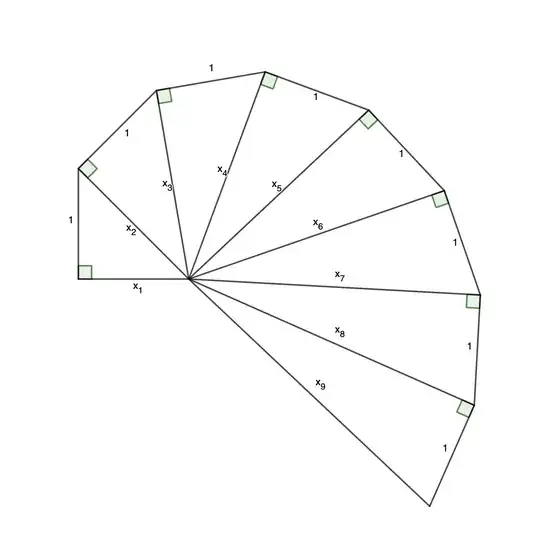I was solving a question :
Let $x_1=1$ and $x_{n+1} = \sqrt{1+x^2_n } \ \ \forall \ \ n\in \mathbb{N}$
Then evaluate $$\lim_{n \to \infty} \left( \frac{x_{n+1}}{x_n} \right)^n$$
The way I did it was :
$$x_1^2=1$$
$$x_2^2=2$$
$$x_3^2=3$$
$$x_4^2=4$$
$$x_{n+1}^2=(n+1)$$
$$\therefore \lim_{n \to \infty} \left( \frac{x_{n+1}^2}{x_n^2} \right)^\frac{n}{2}$$
$$A = \lim_{n \to \infty} \left( \frac{n+1}{n} \right)^{\frac{n}{2}}$$
$$\ln(A) = \lim_{n \to \infty} \frac{1}{2} \frac{\ln\left( 1+ \frac{1}{n} \right)}{\frac{1}{n}} $$
Applying L'Hopital's rule :
$$\ln(A) = \frac{1}{2}$$
$$A = \sqrt{e}$$
But what I think is that this could also be solved using a geometric approach. I believe so because the recurrence relation given is similar to the Pythagoras Theorem.
$$x_{n+1}^2 = 1^2 + x_n^2$$
I tried to draw the diagram for something like this :
However all I could conclude was the indeterminate form the was forming :
For the the limit is of the secant of the base angle of the triangle ( $(\sec \alpha)^n$) with $x_n$ as the base.
i.e. the limit becomes :
$$\lim_{n \to \infty} \sec^n (\alpha_n)$$
which I can see that as $n$ approaches $\infty$, $\alpha_n$ will keep decreasing until we can say $x_n \approx x_{n+1}$, so it is a $(1)^\infty$ form.
So my question is :
How would one prove the above question using geometry?
